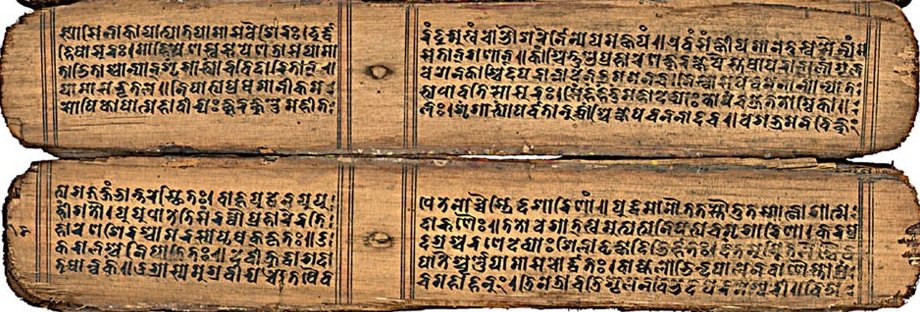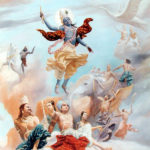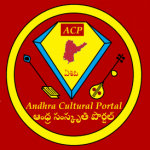At long last, we touch on Literature proper here at the Andhra Cultural Portal.
The importance and impact of this aspect of Indian Civilization and Andhra Culture cannot be minimized. After all, the stories, heroes & heroines, great romances, beautiful places, and wondrous accomplishments of yore are all preserved in and passed on via the literature of a people. It is this, the documentation of the sum total of a civilization’s life, society, and above all, values that connects the young with the old, and for those yearning for star-crossed sringara, connects lover with lover as well. However, to properly appreciate the nuances of a sophisticated culture’s Literary Accomplishments, one must first understand the structural theory it is founded upon.
Those of you following us on Twitter may have seen our recent tweets about videos and articles educating layreaders on the logic and principles of Classical Indian Music and Artistic systems. In that light we continue today with the first in a series on Classical Indic Literature: Literary Theory.
Intro to Classical Indic Literature

India’s Classical Literature Traditions indubitably begins with its unmatched Sanskrit Literary Heritage. By some counts of Indologists, there are some 30 million Sanskrit Texts on various subjects: some political, some religious, some scientific, some literary, some romantic, some historical, and many not even properly catalogued.
In the recent past, the study of Sanskrit has been highly and unfairly politicized. It was not just the language of Brahmins nor was it limited only to Vedic rite. In fact, Sanskrit was the language of high culture, and the speech of the elite and refined. Although most of the credentialed-but-ignorant think its poetry was merely limited to the epic Ramayana and Mahabharata; the reality, however, is that there is a galaxy of romantic poetry and comedic prose in this most elegant of tongues. Poets and Dramatists ran the spectrum and included such literary jewels as Kalidasa, Bhavabhuti, Bhasa, and Dandin. Poems such as Meghadootam and Uttaramacarita captivated our forbears with their sentiments of passionate love. Plays such as AbhignanaSakuntala (Recognition of Sakuntala) and Malavikagnimitra (The Romance of Malavika & Agnimitra)made their heroic and comedic marks as far as Germany and beyond, with the former even developed into an Opera during the Enlightenment era.
Tragically, due to the vicissitudes of history and the travesty of politics, Classical Indic Literature was neglected, much like the Classical Indian Education. Therefore, to properly appreciate the literary accomplishments of Ancient India, one must first be properly acquainted with its literary theory and creative logic. Much like aesthetics is taught to artists, and music theory to musicians, so to is it with the civilized written word.
While our tradition maintains that Dharmic Civilization’s musical and theatrical canons originate with the Saama Veda (the fourth of the Vedas–the other three being the Rig, Yajur, and Atharva), India’s first great treatise specifically on these canons is the Natya Sastra of Sage Bharata.
Classical Indic Literary Theory

Classical Indic Literary Theory was highly developed, with a host of treatises expounding its structure and a constellation of commentaries applying its critical theory. Works such as Ghantapatha (commentary on Kiratarjuneeya) and Saahithyadarpana along with names such as Jaggaadhara, Bhaamaha (a rhetorician), and Andhra’s own Mallinatha respectively provide expository on detailed structural theory and incisive analysis. Unlike today, many of these critics and commentators were successful litterateurs in their own right.
The origin of Classical Indian literary theory is traced to the Sanskrit treatise of Rishi Bharata, Natya Sastra. Natya translates to the performance arts (histrionics). Conservatively dated to 200 B.C.E, but very likely much earlier,”[i]ts comprehensive treatment of artistic experience, expression and communication, content and form emerges from an integral vision which flowers as a many-branched tree of all the Indian arts”.
This mighty work runs the gamut from literature, music, and dance to painting, sculpture, and architecture. While a discussion of this seminal opus of genius could take a series of blog posts or a book itself, the relevant aspect for our post today is the originality of Bharata Muni’s rasa theory, and its pervasiveness in not only dance and music, but literature as well.
The Rasa
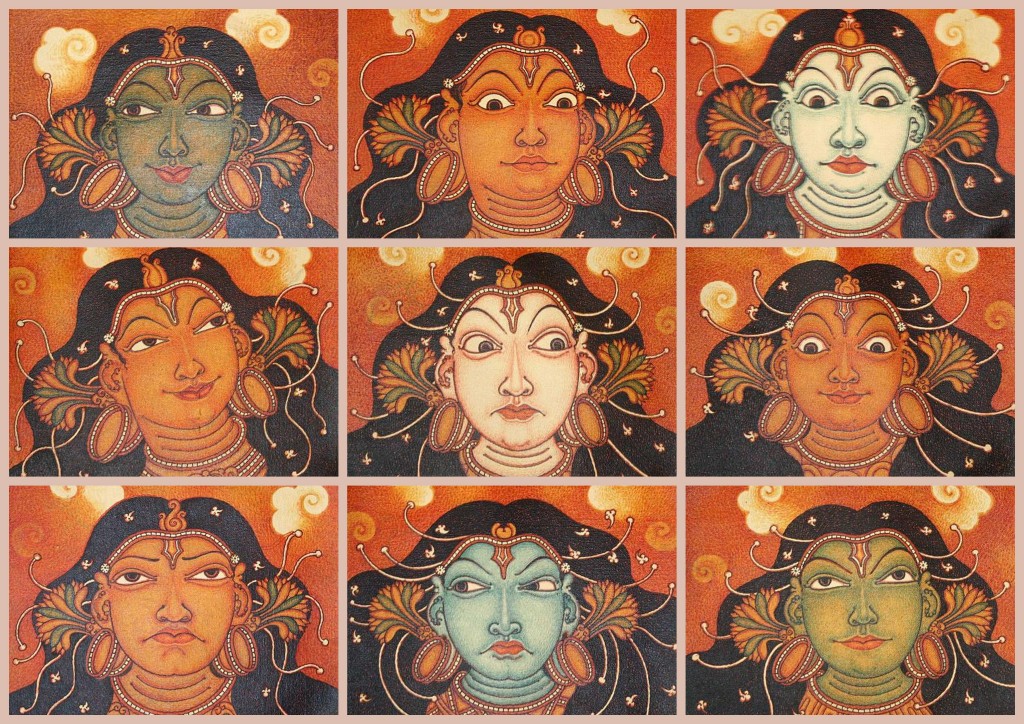
Rasa theory is the outstanding contribution of Classical India to World music, dance, and above all literature. This sentiment is the lasting impression or feeling of the author that he/she aims to impress upon the audience. These are nine in number (hence the term Nava Rasa): Sringara (Romantic), Veerya (Heroic), Haasya (Comedic), Karuna (Pathos), Raudra (Furious), Bhayaanika (Frightful), Bibhatsa (Loathsome), Adhbuta (Marvelous), and finally Shaantha (Calming).
The Sthayibhaava is the leitmotif or permanent sentiment of a composition. There are generally eight in number, based on eight of the nine rasas. They are as follows: rati (erotic), haasa (comic), shoka (sorrowful), krodha(angering), utsaha (enlivening), bhaya (frightening), jugupsa (disgusting), and vismaya (amazing). A ninth, sama (tranquility), is associated with Shaantha
Bhaava is the complete affecting of the heart by any emotion. Vibhaava is the Excitant which builds up the main sentiment and is divided into Aalambana, the subject (i.e. hero, heroine) of the Rasa and Uddeepana or the object that excites (i.e. the moon, beauty, seasons, etc). Anubhaava means the Ensuant. This is the “outward manifestation of internal feelings, through the eyes, face, etc.”
There are other literary elements such as metre (chandah); however, such an expository on the Natya Sastra is best dealt with another day, the present focus being literary theory in general.
Dramatics

The Literary structure of Classical India chiefly aggregates into Dramatics and Poetics.
Literature (saahithya) in Sanskrit has typically been divided into drusya (what can be seen or exhibited on stage) and sravya (what can only be heard or read).
Dramatics falls into the first category. Nataka is the word for a play, while rupaka is the term applied to dramatic compositions. Minor or short dramas, such as the Ratnavali of Sri Harsa Deva (Emperor Harsha Vardhana of Kanyakubjya (Kannauj)), are called Natikas. While there are 17 other classes, they needn’t be examined for our purposes.
The 3 main aspects of a Rupaka are (1) The Plot (Vasthu) (2) The Hero (Neta) (3) The Sentiment (Rasa). There are two main kinds of Vasthu: Principal (Adhikaarika ) and Accessory (Prasangika ). The Principal Plot is that which concerns the main characters of the piece and the central storyline. The Accessory Plot is that which deals with the supporting characters, and may in fact further the Principal Plot. There are two kinds of Prasangikas: Pataka and Prakari. The Pataka (meaning : “Banner”) “is an episode by which the progress of the plot is illustrated, furthered or hindered”. This further piques the audience’s interest in the story. It frequently spans the entire play to the very end. In contrast, the Prakari is only a short and minor episode of limited importance. The principal characters do not play any role here.
The other main plot devices in the classical Indic drama are the bija (seed), bindu (drop), and karya (the final issue or object of the plot). Together with the above two, these five dramatic constructs are called Arthaprakritis. Vasthus may borrow from history (Natakas) or may be wholly or partly fictitious (Prakarana).
The five stages of a play are called Avastha (conditions): (1) Aarambha(Beginning) (2) Yatna (Efforts ) (3) Praaptyaasa (Prospects of Success) (4) Nityataapti (Obstacle Removal) and (5) Phalaagama ( Attainment of Object). Links to connect them and other parts of the main action are called Samdhis, of which there are five kinds (mukha, pratimukha, garbha, avamarsa, and nirvahana). Mukha is where the seed is sown (including the various rasas), pratimukha is where the chief end is revealed, the garbha establishes the attainment or non-attainment of the object, avarmarsa is where the seeds attain growth and the attainment sprouts, and finally, the nirvahana is the consummation of the all of the preceding, in the story’s denouement.
The Hero of the Play (Neta) is expected to be “modest, decorous, comely, munificent, civil, of sweet address, eloquent, [and]…from a noble family” or a ministerial family. There are four kinds of hero: Dhirodaatta, Dhiralalita, Dhirashaantha, and most importantly, the Dhirodatta.
The Dhirodatta is the hero of sublime qualities. He is known for his magnanimity, patience, modesty, self-possession, resolve, concealed high spirit, valor, and keeping of promises.
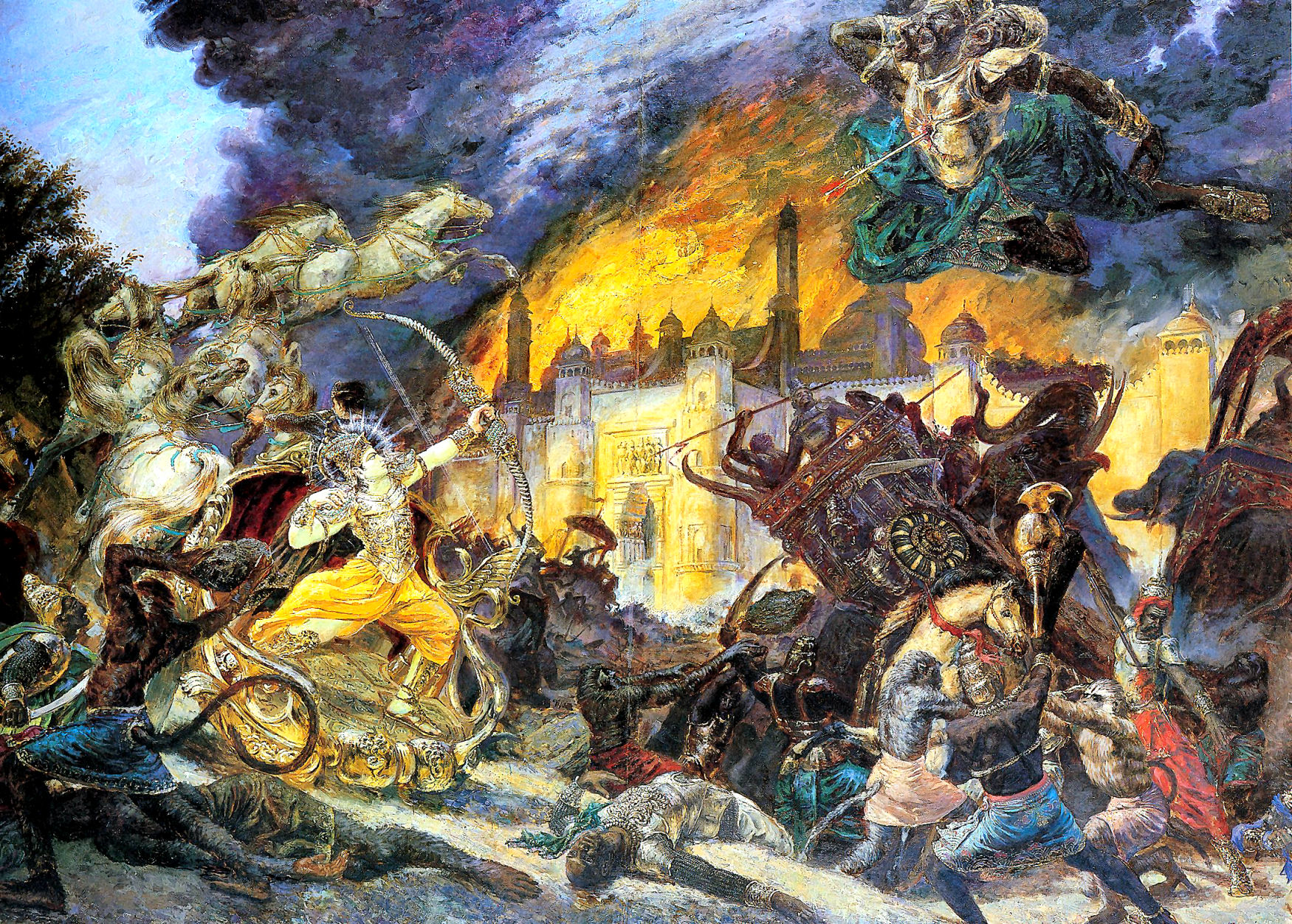
Rama is the best example of this as well as Veerya rasa (heroism/manliness). This quality of his is best seen in the drama Mahaviracarita by Bhavabhuti. Rama’s romantic (sringara) qualities are highlighted in the same dramatist’s follow up work, Uttararamacarita.
The Hero’s principal assistants are the Peetamarda (key figure in the accessory plot/episodes), who is clever in speech, loyal to the Neta, and only slightly lesser to him in his manly qualities. Next is the famous Vidusaka, or comic relief. He is known for his wit and for assisting the hero in his romances. Finally, there is the Vita, who is skilled in one art (of the traditional 64).

The Nayika is the heroine, and must generally be the equal of the hero in his various virtues, as Sita is to Rama. She may be the wife of the hero, a woman who already is obligated to another, or a common woman. The helpers of the heroine are the sakhi (friend), daasi (servant), dhaatreyi (nurse or mother), and patikesika (neighbor).
The hero’s rival, or villain, is called the Pratinaayaka, and is generally “avaricious, bold, impetuous, criminal and of evil conduct”.
The Nataka is typically conducted by commencing with a benediction (svastivachana), followed by a prastaavana (prologue) introduced by the Nandi (the introductory portion which suggests the plot). All this is conducted by the Sutradhara (stage-manager). Typically divided into Scenes and Acts (which may be as many as five to ten in number), the Classical Nataka of Ancient India had long-standing rules on structure and even subject-matter. There was a historical rule against tragedies, since the rasas themselves are thought to imbue a spiritual quality in the audience. However, at least 1 play, Nagananda by Sri Harsa, is known to have broken this custom.
The most intriguing aspect of the classical drama is the diversity of languages. The aristocracy and other elites are seen conversing in Sanskrit, with the more common folk relying on various types of Prakrit for dialogue.
Poetics
 Poetry is divided into Prose (gadhya), Verse (padhya), and Mixed (misra). The vast majority of our classical literature has been in padhya.
Poetry is divided into Prose (gadhya), Verse (padhya), and Mixed (misra). The vast majority of our classical literature has been in padhya.
Gadhya is further divided into katha and aakhyaayika. The distinction between the two is generally considered to be minimal.The modern understanding is that the aakhyaayika gives a detailed prose narration of the litterateur’s family history and background (i.e. auto-biographical), while the katha is less restricted, in short verse, and therefore, is seemingly less formal. This is because the latter is rarely divided into chapters, and there are no embedded stanzas suggestive of future events.
Aakhyaayika is also strictly narrated by the hero, which is not the case in katha. There are other distinctions as well, such as names of chapters in Aakhyaayika being called ucchvaasa, but they are not important for our discussion today. The key take away is that, according to the treatise Alamkaarasamgraha, the Aakyaayika is based on historical facts and events, whereas a katha is considered purely fictional.
We end this post with a brief sample of a famous Aakhyaayika by a famous poet and scholar of Poetics: The Dasakumaracarita of Dandin.
Dasakumaracarita
One of four known historical prose romances, the Dasakumaracarita of Dandin is a remarkable work. Literally meaning History of the Ten Princes, it is a composition of prose par excellence. The author Dandin is celebrated for his word play (pada-lalityam) in a famous sanskrit sloka (couplet).
Since the author himself will be discussed in detail another time, the work will be the object of brief focus. A truly delightful story, Dasakumaracarita has it all, from political conflict and war to action/adventure to feverish romances. It is centered around the escapades of ten princes and young ministers as they all seek to gain the necessary allies and strength to defeat their King’s enemy. It nevertheless is set in a background that gives a vivid picture of common life and is a detailed rendition of Indian Society during that period.It is divided into three parts: the Purvapithaka (Prologue), Dasakumaracarita proper, and the Uttarapithaka (Epilogue).
This piece of prose is dated to the 6th-7th centuries C.E., although tradition holds that the author was a contemporaneous rival of Kalidasa himself, which would date him to the 1st-4th centuries C.E. While Dandin is also famous for his incisive and erudite work on Poetics, it is his lyrical command of language (apparent even in translation) that truly defines him and this magnum opus of literature.
Frustratingly, due to the baggage of history, only an incomplete portion of the original text was discovered. Thus, it effectively begins in medias res and two of the ten narratives are missing/incomplete. One of the foremost scholars of Sanskrit literature, the late Moreshwar Ramchandra Kale, wrote that the Dasakumaracarita is officially classified as an Aakhyaayika, though it doesn’t appear to carry the main markers of one. Therefore, he designates it a gadhya kaavya (prose poem or prose romance). Whether or not it is based on historical events, the Dasakumaracarita gives us a panoramic view of classical Bharat.
The Ten young noblemen in the story have various run ins with kings from throughout India, including Andhra, further demonstrating Bharat’s historical civilizational unity. While it is particularly famous for making delightful and frequently scintillating reading, we will end this post with a short passage that emphasizes its wisdom more than its word-play.
Foolish, indeed, are the worldly people that place Artha (wealth) and Kama (pleasure) on an equal footing with Dharma (virtue)…To be sure, Artha and Kama cannot come into being without Dharma; but even without regard to them, Dharma alone is the creative cause of final beatitude, and is attainable only by the concentration of the mind. It does not (like Artha and Kama) much depend on external means. Supported (i.e. held up) by the knowledge of the reality, it is not affected by Artha and Kama, howsoever pursued; and, even if affected, it is set right by a little exertion, and redaicating that defect also, it conduces the highest bliss.
References:
- Kale, M.R. Dasakumaracarita of Dandin. New Delhi: MLBD. 2009
- Malhotra, Rajiv. Sulekha. 2002. http://creative.sulekha.com/the-axis-of-neocolonialism_103313_blog
- http://www.exoticindiaart.com/book/details/bharata-natyasastra-IDD947/
